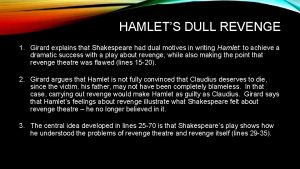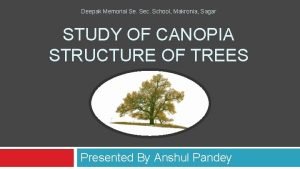Hamlet Tradition of the revenge play Kyan Deepak











- Slides: 11

Hamlet Tradition of the revenge play Kyan, Deepak, Jacob

Hamlet follows the conventions of the traditional revenge play both in its Christian themes, supernatural elements to the plot, as well as unintentional plot development/involvement.

The Substance of Shakespearean Tragedy and the Elizabethan Compromise Paul N. Siegel Hamlet follows closely the traditional revenge play in sense that the Elizebethan world’s Christian values are what drive the act of vengeance. The act of vengeance is not by itself. The fact that his father comes from Purgatory to tell his son suggests a very strong Christian divine impetus for the act of revenge. During this time period the concept of a Divine Providence, and will or supernatural events controlling the actions of people through divine portents and natural events suggest that God is rewarding or punishing mortals. This is seen in plays like Juilius Caesar. This concept is encountered by scholar Henry Hitch Adams. Scholar Siegel proposes that the concept of Providential interference in the plot events of plays and a clear divine presence and a universal Christian moral order

Act 1 Scene 4 But howsoever thou pursuest this act, Unhouseled, disappointed, unaneled. Taint not thy mind, nor let thy soul contrive Against thy mother aught. Leave her to heaven No reckoning made, but sent to my account With all my imperfections on my head. Oh, horrible, oh, horrible, most horrible! If thou hast nature in thee, bear it not. Let not the royal bed of Denmark be A couch for luxury and damnèd incest.

m the ghost of your father, doomed for a certain period of time to walk the earth at night, while during the day I’m trapped in the fires of purgatory until I’ve done penance for my past sins. If I weren’t forbidden to tell you the secrets of I am thy father’s spirit, Doomed for a certain term to walk the night And theconfined day confined in fires, I am thy father’s spirit, And for theforday to fasttoinfast fires, Doomed for a certain term to walk the night Till the foul crimes done in my days of nature And and for the day confined to that fast Iinam fires, Are burnt purged away. But forbid To tell. Till thethe secrets of my prison house, foul crimes done in my days of nature I could a tale unfold whose away. lightest. But word Are burnt and purged that I am forbid Would harrow up thy soul, freeze thy young blood, To tell the secrets of my prison house, I could a tale unfold whose lightest word Would harrow up thy soul, freeze thy young blood, Till the foul crimes done in my days of nature Are burnt and purged away. But that I am forbid To tell the secrets of my prison house, I could a tale unfold whose lightest word Would harrow up thy soul, freeze thy young blood, PURGATORYI am thy father’s spirit, Doomed for a certain term to walk the night

Quotes for article 2 “Sir, in my heart there was a kind of fighting That would not let me sleep. Methught I lay worse than the mutines in the bilboes. Rashly- And praised be rashness for it: let us know Our indiscretion sometimes serves us well When our deep plots do pall; and that do teach us There’s a divinity that shapes our ends, Rough-hew them how we will. ”(ACT FIVE Scene 2) “Since no man of aught he leaves, knows aught, what is’t to leave betimes? Let be. ”(ACT FIVE Scene 2)

Article 2 The Spanish Tragedy and Hamlet: Two Exercises in English Seneca B. L. Joseph The Spanish Tragedy was a play written by a contemporary of Shakespeare by Thomas Kyd also wrote a play known as Ur-Hamlet which some scholars believe is the play upon which Shakespeare’s Hamlet is based on. There are clear plot tropes, and symbols shared between not only Elizabethan works like the Spanish Tragedy, but across history with Roman revenge tragedy works as well. One of which that was noticed was that Shakespeare did believe that revenge was to be punished severely unless having to do with “divine providence”. If the revenge were to be done through this providence, it could be extremely horrible and still be warranted.

Continued Seneca through his play Thyestes and other works introduced the rhetorically impassioned speeches, and the plot trope of the ghost demanding revenge. In this style of Elizabethan revenge drama memorizing rhetorical speeches and reciting them was in fact a form of acting for them. Historically vigourous physical passionate appropriate movements along with recitation of rhetoric made this genre come to life. Lorenzo the murderer in the Spanish tragedy and Claudius in Hamlet both are villains who are sought to be revenged against but dig their own graves, one out of endless guilt, the latter from a poisoning plan gone wrong.

Quotes for Article 3 Act 2 Scene 2 557. 560 (Hamlet’s soliloquy) Act 5 Scene 1 259. 264 A damned defeat was made. Am I a coward? “Hamlet - Why, I will fight with him upon these theme Until my eyelids will no longer wage Who calls me “villain”? Breaks my pate across? Queen - O my son, what theme? Plucks off my beard and blows it in my face? Hamlet - I loved Ophelia. Forty thousand brothers Tweaks me by the nose? Gives me the lie i' throat Could not with all their quantity of love As deep as to the lungs? Who does me this? Make up my sum. What wilt thou do for her? Ha!

Through the use of the tradition of the revenge play, Shakespeare is able to give Hamlet more emphasis on the revenge tragedy as it highlights Hamlet’s flaw. Lawrence Danson argues that for a play to follow the tradition of a revenge play the protagonist will stumble upon the situation for which they are able to take their revenge Concludes that while the flaw may differ from play to play they all lead to the character being unsure of their intentions for revenge This allows for the emphasis of Hamlet’s flaw, and show the flaw is affecting his troubled intentions and motivations Allows for a more dramatic effect, and emphasizes the “responsiveness of the audience” by making the audience sympathize for Hamlet and want him to achieve revenge and die

Works cited Danson, Lawrence N. "The Device of Wonder: Titus Andronicus and Revenge Tragedies. " Texas Studies in Literature and Language 16. 1 (Spring 1974): 27 -43. Rpt. in Shakespearean Criticism. Ed. Lynn M. Zott. Vol. 68. Detroit: Gale, 2003. Literature Resource Center. Web. 17 Oct. 2016. Joseph, B. L. "The Spanish Tragedy and Hamlet: Two Exercises in English Seneca. " Classical Drama and Its Influence: Essays Presented to H. D. F. Kitto. Ed. M. J. Anderson. New York: Barnes & Noble, 1965. 119 -134. Rpt. in Shakespearean Criticism. Ed. Michelle Lee. Vol. 111. Detroit: Gale, 2008. Literature Resource Center. Web. 17 Oct. 2016. Siegel, Paul N. "The Substance of Shakespearean Tragedy and the Elizabethan Compromise. " Shakespearean Tragedy and the Elizabethan Compromise. New York: New York University Press, 1957. 81 -98. Rpt. in Shakespearean Criticism. Ed. Michelle Lee. Vol. 101. Detroit: Gale, 2006. Literature Resource Center. Web. 17 Oct. 2016.




















